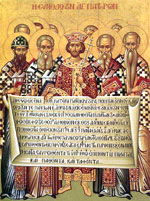

Nicene Creed
The Nicene Creed should be called the Nicene-Constantinopolitan Creed since it was formally drawn up at the first ecumenical council in Nicea (325) and at the second ecumenical council in Constantinople (381).
The word creed comes from the Latin credo which means "I believe." In the Orthodox Church the creed is usually called The Symbol of Faith which means literally the "bringing together" and the "expression" or "confession" of the faith.
In the early Church there were many different forms of the Christian confession of faith; many different "creeds." These creeds were always used originally in relation to baptism. Before being baptized a person had to state what he believed. The earliest Christian creed was probably the simple confession of faith that Jesus is the Christ, i.e., the Messiah; and that the Christ is Lord. By publicly confessing this belief, the person could be baptized into Christ, dying and rising with Him into the New Life of the Kingdom of God in the name of the Father, and of the Son, and of the Holy Spirit.
As time passed different places had different credal statements, all professing the identical faith, yet using different forms and expressions, with different degrees of detail and emphasis. These credal forms usually became more detailed and elaborate in those areas where questions about the faith had arisen and heresies had developed.
In the fourth century a great controversy developed in Christendom about the nature of the Son of God (also called in the Scripture the Word or Logos). Some said that the Son of God is a creature like everything else made by God. Others contended that the Son of God is eternal, divine, and uncreated. Many councils met and made many statements of faith about the nature of the Son of God. The controversy raged throughout the entire Christian world.
It was the definition of the council which the Emperor Constantine called in the city of Nicea in the year 325 which was ultimately accepted by the Orthodox Church as the proper Symbol of Faith. This council is now called the first ecumenical council, and this is what it said:
We believe in one God, the Father Almighty, Maker of heaven and earth, and of all things visible and invisible. And in one Lord Jesus Christ, the Son of God, the only-begotten, begotten of the Father before all ages. Light of Light; true God of true God; begotten, not made; of one essence with the Father, by whom all things were made; who for us men and for our salvation came down from heaven, and was incarnate of the Holy Spirit and the Virgin Mary, and became man. And He was crucified for us under Pontius Pilate, and suffered, and was buried. And the third day He rose again, according to the Scriptures; and ascended into heaven, and sits at the right hand of the Father; and He shall come again with glory to judge the living and the dead; whose Kingdom shall have no end.
Following the controversy about the Son of God, the Divine Word, and essentially connected with it, was the dispute about the Holy Spirit. The following definition of the Council in Constantinople in 381, which has come to be known as the second ecumenical council was added to the Nicene statement:
